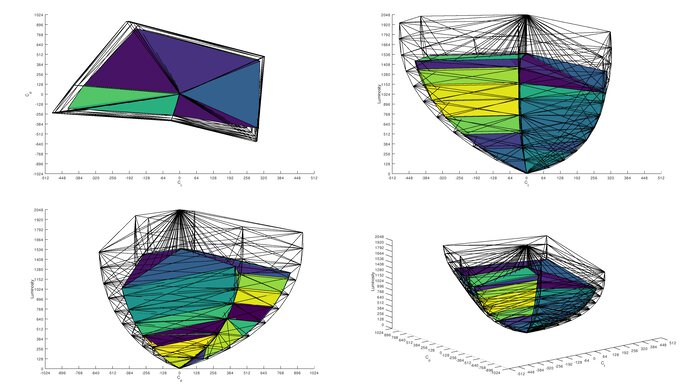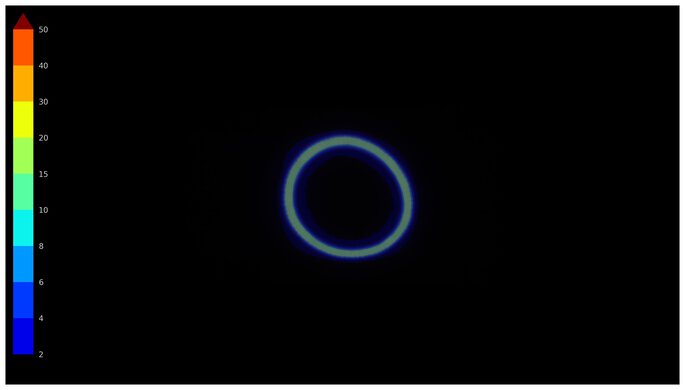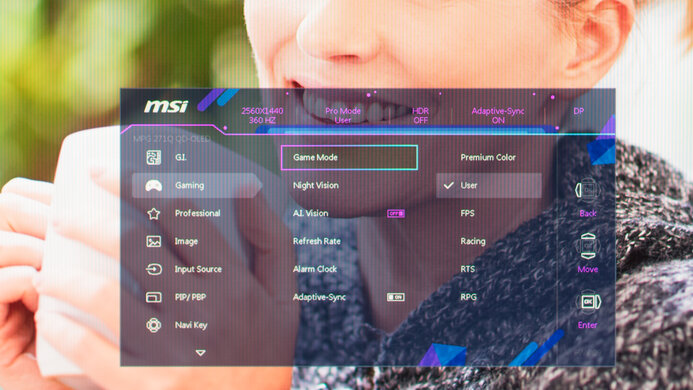The MSI MPG 271QRX is a 27-inch 1440p premium gaming monitor with a QD-OLED display. It joins several new QD-OLEDS of this size that are entering the market in 2024, like the Dell Alienware AW2725DF and the Samsung Odyssey OLED G6/G60SD. It has several gaming features, including a 360Hz refresh rate and support for all VRR formats, as well as full-bandwidth HDMI 2.1 ports. It also uses a heatsink instead of a fan to dissipate heat. It has several non-gaming features, like a KVM switch, which lets you switch between sources and use the same keyboard and mouse connected to the monitor. The USB-C port lets you connect your laptop and charge it simultaneously with 90W of power delivery. MSI also offers a three-year warranty on the monitor, which includes burn-in coverage.
Our Verdict
The MSI MPG 271QRX is superb for PC gaming. It has an extremely high 360Hz refresh rate, which is ideal for competitive gaming, and supports all common VRR formats. Its near-instantaneous response time results in extremely crisp images with no ghosting. It also has low input lag as long as you update it to the latest firmware. On the plus side, its near-perfect contrast ratio means deep blacks are visible next to bright highlights in darker rooms, and small highlights get bright enough to pop. Colors are also extremely rich and vivid, so gaming environments feel vibrant and life-like.
Near-infinite contrast for deep blacks in dark rooms.
- 360Hz refresh rate and VRR support.
- Near-instantaneous response time.
- HDMI 2.1 bandwidth.
- Noticeable VRR flicker with changing frame rates.
- Needs firmware update for lowest input lag.
The MSI MPG 271QRX is fantastic for console gaming. It has HDMI 2.1 bandwidth and supports any signal with the Xbox Series X|S and PS5, but with a 1440p resolution, 4k games aren't the sharpest. It has outstanding picture quality with a near-infinite contrast and bright and vivid colors. It also has a near-instantaneous response time that makes motion look extremely sharp, and it has low input lag, but you need to update it to the latest firmware to get that.
Near-infinite contrast for deep blacks in dark rooms.
- Near-instantaneous response time.
- HDMI 2.1 bandwidth.
- Small highlights pop in HDR.
- Needs firmware update for lowest input lag.
- Limited to 1440p resolution.
The MSI MPG 271QRX is decent for office work in certain circumstances. Its large 27-inch screen makes it easy to multitask, and this monitor has fantastic ergonomics, so you can place it in your preferred position for a long work session. It also has a KVM switch, so you can switch between sources and use the same keyboard and mouse connected to the monitor. However, its triangular subpixel arrangement makes text appear slightly less clear than other 27-inch 1440p monitors. OLEDs like this one are prone to burn-in with constant exposure to the same static elements over time.
Decent reflection handling.
- Wide viewing angles.
- KVM switch.
- 90W power delivery over USB-C.
- Worse text clarity than some other 27-inch 1440p monitors.
- Not bright enough to fight the most glare.
- Prone to burn-in.
Black levels rise in bright rooms.
The MSI MPG 271QRX is excellent for media creation but has some limitations. It has an accurate sRGB mode, though you need to calibrate it for the most accurate image. Luckily, its incredibly vivid colors and extremely wide HDR gamut range allow you to edit videos in HDR with great accuracy. However, its triangular subpixel arrangement means text appears slightly less clear than other 27-inch 1440p monitors. OLEDs like this one are prone to burn-in with constant exposure to the same static elements over time.
Decent reflection handling.
- Wide viewing angles.
- KVM switch.
- 90W power delivery over USB-C.
- Small highlights pop in HDR.
- Worse text clarity than some other 27-inch 1440p monitors.
- Not bright enough to fight the most glare.
- Prone to burn-in.
Black levels rise in bright rooms.
The MSI MPG 271QRX has decent brightness. It's fine if you have a few lights around, but it doesn't get bright enough to fight intense glare. It also gets bright enough in HDR for small highlights to stand out against the rest of the image, but larger highlights are dimmer.
- Small highlights pop in HDR.
- Not bright enough to fight the most glare.
The MSI MPG 271QRX has a near-instantaneous response time, resulting in exceptionally sharp motion.
- Near-instantaneous response time.
- Outstanding refresh rate compliance.
The MSI MPG 271QRX is outstanding for HDR. Its extremely wide HDR color gamut ensures movies and shows look as creators intended, with vivid colors and subtle dark shades visible next to each other. It also has near-infinite contrast, and deep blacks are visible next to bright highlights in darker rooms.
Near-infinite contrast for deep blacks in dark rooms.
- Displays wide range of vivid colors.
The MSI MPG 271QRX has outstanding SDR picture quality, displaying deep and inky blacks and a wide range of colors.
Near-infinite contrast for deep blacks in dark rooms.
- No blooming around bright objects.
The MSI MPG 271QRX has excellent accuracy. Although it has a dedicated sRGB mode that has great accuracy, you still need to calibrate it for the best accuracy. However, it has super gray uniformity, so it keeps that accurate image the same throughout the entire screen.
- Great accuracy in sRGB mode.
- Need full calibration for best accuracy.
Performance Usages
Changelog
-
Updated Dec 01, 2025:
We updated the firmware to FW.203, and we retested the HDR Brightness in the 'EOTF Boost' mode. We also retested the HDR Color Gamut and Color Volume in the 'User' picture mode.
- Updated Nov 10, 2025: We've converted this review to Test Bench 2.1.1. We removed the Vertical Viewing Angle test.
-
Updated Jun 13, 2025:
We updated text throughout to match the new and updated tests with Test Bench 2.1, including in the Verdict section.
- Updated Jun 13, 2025: We've converted this review to Test Bench 2.1. This includes new tests for Direct Reflections, Ambient Black Level Raise, and Total Reflected Light. You can see all the changes in the changelog.
Check Price
Differences Between Sizes And Variants
We tested the 27-inch MSI MPG 271QRX QD-OLED, which is the only size available for this monitor. It's one of several monitors in MSI's 2024 lineup that feature a QD-OLED panel, including the MPG 321URX QD-OLED and the MPG 271QPX QD-OLED. However, the 321URX is a 32-inch 4k monitor with a 240Hz refresh rate, and while the 271QPX is very similar to the 271QRX, the 271QPX lacks the 271QRX's USB-A ports and only delivers 15W of power over USB-C. The results are only valid for this model.
| Model | Size | Resolution | Panel Type | Refresh Rate |
|---|---|---|---|---|
| MPG 271QRX QD-OLED | 27" | 1440p | QD-OLED | 360Hz |
Our unit was manufactured in January 2024; you can see the label here. We originally tested it with firmware FW.009, but updated it to FW.010 and retested the HDR Color Gamut and VRR Flicker. The update also adds a DSC toggle, which you can read about in Refresh Rate. In July 2024, MSI released firmware FW.011, which fixes Input Lag issues. There was another update in November 2025 firmware FW.203 (also known as FW.018 and FW.109), which adds an 'EOTF Boost' mode that improves the HDR Brightness.
Popular Monitor Comparisons
The MSI MPG 271QRX QD-OLED is a superb high-end gaming monitor, but it has some limitations. Its response time and image quality are among the best available, and it works well at high refresh rates. However, it has input lag issues at lower refresh rates that only get fixed with a firmware update, so if you want something with lower input lag out of the box, you can also check out the Gigabyte AORUS FO27Q3.
See our recommendations for the best 1440p monitors, the best 27-inch gaming monitors, and the best OLED monitors.
The MSI MPG 271QRX QD-OLED and the Dell Alienware AW2725DF are premium 27-inch gaming monitors with very similar performance. If connectivity is important to you, the MSI is the better choice, as it has a KVM switch and a USB-C port with 90W of power delivery.
The MSI MPG 271QRX QD-OLED and the ASUS ROG Strix OLED XG27AQDMG are 27-inch OLED gaming monitors. The ASUS is a better option if you're gaming in a bright room, as deep blacks don't appear slightly purple when there's a lot of ambient light on the screen, and it gets much brighter. However, if you like to play competitive games, the MSI is a better choice, as it has lower input lag and a higher refresh rate.
The MSI MPG 271QRX QD-OLED and the Samsung Odyssey OLED G60SD S27DG602S are competing 1440p, 360Hz QD-OLEDs. While there are some minor differences in performance, the main difference between them is their screen coatings. The MSI has a glossy coating that results in a clearer image than the matte coating of the Samsung, which in turn does a better job at reducing glare. The MSI also has some extra perks, like a USB-C port and a KVM switch, so it's the better choice for connecting different devices and computers to it.
The MSI MPG 271QRX QD-OLED and the LG 27GS95QE-B are premium 27-inch gaming monitors. If vivid HDR colors are important to you, then the MSI is the better choice, as it has far more vibrant HDR colors.
Test Results

The ergonomics are fantastic. It has excellent height adjustment, so it's easy to place in your preferred position for a long gaming session. It also has a good swivel range, so it's easy to share your screen with someone else. The stand features a cutout for cable management.
The MSI 271QRX has a near-infinite contrast ratio, as its QD-OLED panel can turn individual pixels on and off. However, in brighter environments, this monitor appears slightly purple instead of black when displaying very dark scenes. As a result, you'll want to minimize the amount of light shining on the monitor to get the best real-world contrast performance.
The monitor doesn't have a backlight, so it doesn't require a local dimming feature. However, with a near-infinite contrast ratio, there isn't any blooming around bright objects, and it's the equivalent of a perfect local dimming feature. We still film these videos on the monitor so you can see how the screen performs and compare it with a monitor that has local dimming.
The SDR brightness is adequate. It gets bright enough to fight glare in rooms with a few lights, though it can't overcome glare if a bright light shines directly on the monitor. It's best used in a darker environment anyway, as deep blacks appear slightly purple when enough light shines on the display. These results are from after calibration in the 'User' Game Mode with the Brightness at its max, Pixel Shift set to 'Slow,' and Static Screen Detection turned 'Off.'
If you want a brighter QD-OLED, check out the ASUS ROG Strix OLED XG27ACDNG.
Settings
- Gaming: User
- DisplayHDR: EOTF Boost
- Brightness: Locked to max
- All MSI OLED Care settings disabled.
The MSI 271QRX has decent HDR brightness. Very small highlights pop against the rest of the image, though larger highlights don't. As of firmware FW.203 (also known as FW.018 and FW.109), which was released in November 2025, there's an 'EOTF Boost' mode that you can use. It has very accurate PQ EOTF tracking with a sharp cut-off at its peak brightness, so it isn't performing any tone mapping before your source does. This tracking is better than the 'Peak 1000 nits' mode, which has a slow roll-off before reaching its peak brightness. The 'EOTF Boost' mode also gets a bit brighter than the 'Peak 1000 nits' mode.
There's also the 'True Black 400' mode, which has more consistent brightness between different content, as you can see with the results below:
| Window Size | Peak | Sustained |
|---|---|---|
| 2% | 450 cd/m² | 446 cd/m² |
| 10% | 456 cd/m² | 454 cd/m² |
| 25% | 368 cd/m² | 367 cd/m² |
| 50% | 314 cd/m² | 312 cd/m² |
| 100% | 265 cd/m² | 264 cd/m² |
| EOTF Graph | ||
The accuracy before calibration in the sRGB mode is great. While some colors are oversaturated, the overall color accuracy is excellent. Additionally, while the color temperature is a bit warm, the white balance is superb. Finally, very dark and very bright scenes are too dark.
However, using the sRGB mode locks some settings like the Contrast and Color Temperature. You have to use another mode to unlock those settings, though other picture modes are less accurate before calibration, as you can see here.
The MSI 271QRX has fantastic accuracy after calibration, and you won't notice any inaccuracies.
The SDR color gamut is fantastic. It fully displays all colors in the sRGB space. It also has excellent coverage of the Adobe RGB space. However, red and green colors are both inaccurate in Adobe RGB, which isn't ideal if you're editing content with those colors.
The HDR color gamut is exceptional. It displays the full range of colors in DCI-P3 and a wide range of colors in Rec. 2020. Updating it to firmware FW.203 (also known as FW.018 and FW.109), which was released in November 2025, provides slightly better gamut coverage than previous firmware if you use the 'User' picture mode, as you can't select the 'Display P3' anymore like on previous firmware.
The monitor has a fantastic HDR color volume. Colors look exceptionally vivid, and the monitor displays dark and bright colors extremely well. Updating it to firmware FW.203 (also known as FW.018 and FW.109), which was released in November 2025, provides slightly better color volume than previous firmware if you use the 'User' picture mode, as you can't select the 'Display P3' anymore like on previous firmware.
The horizontal viewing angle is exceptional. The image remains consistent from any angle without inconsistencies, and you can easily share your screen with someone else.
The text clarity is decent, though it's not as good as some other 27-inch 1440p monitors. This is because of the monitor's triangular subpixel arrangement. Enabling Windows ClearType (top photo) improves the boldness of letters. These photos are in Windows 10, and you can also see them in Windows 11 with ClearType on and with ClearType off.
Due to the triangular subpixel layout, there's some color fringing around letters and at the edge of windows, though it's hard to see unless you look closely at the monitor. Although we didn't experience any eye strain during testing, this changes from person to person, and it depends on how sensitive you are to this subpixel layout.
This monitor handles direct reflections well. Because it has a glossy coating, it reflects light straight back and doesn’t spread it out.
This monitor has poor black levels in a bright room. Any ambient light causes the black levels to rise, and they look purple in bright rooms, which is typical of QD-OLEDs as they lack a polarizer.
After firmware update FW.010, which MSI released in May 2024, you can now enable or disable Display Stream Compression (DSC). With it on, you can select a 60Hz, 240Hz, or 360Hz refresh rate over a DisplayPort connection with the monitor's native resolution. Without this update, DSC is always on, and this prevents NVIDIA's deep learning dynamic super resolution (DLDSR) and dynamic super resolution (DSR) technologies from working properly, which can reduce image quality if you would normally use DLDSR/DSR. If you want a monitor with a higher refresh rate of 480Hz, take a look at the LG 27GX790A-B.
NVIDIA
VRR Min
VRR Max
DisplayPort
<20Hz
360Hz
HDMI
<20Hz
360Hz
AMD
VRR Min
VRR Max
DisplayPort
<20Hz
360Hz
HDMI
<20Hz
360Hz
On top of supporting FreeSync VRR and G-SYNC compatibility, it also supports HDMI Forum VRR.
| Refresh Rate | CAD Heatmap | RT Chart | Pursuit Photo |
| 358 | Heatmap | Chart | Photo |
| 240 | Heatmap | Chart | Photo |
| 165 | Heatmap | Chart | Photo |
| 144 | Heatmap | Chart | Photo |
| 120 | Heatmap | Chart | Photo |
| 100 | Heatmap | Chart | Photo |
| 80 | Heatmap | Chart | Photo |
| 60 | Heatmap | Chart | Photo |
The MSI MPG 271QRX has outstanding motion handling across its entire refresh rate range with VRR enabled. CAD remains low throughout and there's minimal blur with fast-moving objects.
The refresh rate compliance is outstanding. As it has a near-instantaneous response time, it makes full color transitions before drawing the next frame.
The monitor doesn't have an optional black frame insertion feature to reduce persistence blur further.
The MSI MPG 271QRX has noticeable VRR flicker with changing frame rates, and it's especially noticeable in dark scenes and dark areas of brighter scenes. This can be distracting while gaming, but it's common with most OLEDs and isn't a problem if your PC can maintain a consistent frame rate. Although MSI released firmware update FW.010 on May 6, 2024, to reduce this VRR flicker, it doesn't improve it.
The MSI MPG 271QRX has very low input lag as long as you have the firmware updated to FW.011, which MSI released in July 2024. Before this update, the input lag increased a lot more at 120Hz and 60Hz, especially with VRR disabled, and it changed depending on the combination of settings used, as you can see here. After the update, the input lag remains low regardless of the combination of settings or connection you use, including if you use VRR or DSC. If you're looking for a monitor with even lower input lag, check out the Sony INZONE M10S.
If you want a monitor with the same outstanding picture quality but prefer a more detailed image, check out the 4k MSI MPG 322URX QD-OLED.
The MSI MPG 271QRX works well with the PS5 and supports all the console's features, as long as you have Console Mode enabled. It can also downscale 4k signals, which results in a more detailed image than native 1440p.
The MSI MPG 271QRX works well with the Xbox Series X|S and supports all the console's features as long as you have Console Mode enabled. This includes downscaling a 4k signal so you can use HDR with the Xbox, as the console doesn't support HDR with 1080p and 1440p signals.
With the USB-C port, you can connect your laptop and charge it simultaneously, as the 90W of power delivery is enough to charge most laptops while they're running.
| Connection | HDMI 2.0 | HDMI 2.1 | USB-C |
| Max Refresh Rate | 60Hz | 360Hz | 240Hz |
| VRR Range | N/A | 48-360Hz | 48-240Hz |
| HDR | Yes | Yes | Yes |
The MSI MPG 271QRX works well with macOS. HDR works properly, and the Automatic Brightness Limiter (ABL) doesn't cause noticeable problems during desktop use. The KVM switch also works well, even when switching between a macOS device and a PC, and automatically switches between devices in 2-3 seconds if one computer goes to sleep. When using a MacBook, windows return to their original position when waking the laptop up from sleep.
The MSI MPG 271QRX has several extra features to improve the user experience. It has a KVM switch that makes it easy to switch between sources and use the same keyboard and mouse connected to the monitor. It works well and is responsive even if changing sources takes a couple of seconds.
As with other OLED panels, this monitor has a few settings to help mitigate the risk of permanent burn-in when exposed to the same static elements over time. Some of these include:
- Pixel Shift: This moves the image a few pixels at a time so that each pixel isn't always displaying the same thing. You can set it to 'Slow,' 'Normal', or 'Fast'.
- Multi Logo Detection: Reduces the brightness of static elements, like logos, that stay on the screen for a long time.
- Panel Protect: This feature activates a pixel refresh cycle to reduce the risk of permanent burn-in. A message pops up every four hours of usage to run the cycle, which takes a couple of minutes to complete. However, the message can pop up at any time, including while you're gaming. You can adjust the feature to activate after 16 hours instead of 4, though this may make your screen more prone to burn-in.
The monitor has some other extra features, including:
- Mystic Light: A soft ambient light that you can sync with other Mystic Light products.
- HDMI CEC: It supports the HDMI CEC standard, so it will automatically turn on when you power up compatible devices like consoles.
- Smart Crosshair and Optix Scope: These are two different settings for various crosshairs and scope features, making it easier to see opponents in games. Your games' anti-cheating tools won't detect it, giving you a competitive advantage.
































































